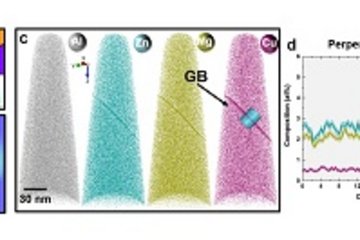All genres
1.
Journal Article
Atomic level bonding mechanism in steel/aluminium joints produced by cold pressure welding. Materials 7, 100396 (2019)
2.
Journal Article
3D cold pressure welded components – From the bonding mechanisms to the production of high strength joints. Journal of Materials Science & Technology 50 (8), pp. 913 - 923 (2019)
3.
Journal Article
On the Role of Trigger Signal Spreading Velocity for Efficient Self-Healing Coatings for Corrosion Protection. Journal of the Electrochemical Society 165 (16), pp. C1017 - C1027 (2018)
4.
Journal Article
Hydrogen Permeation as a Tool for Quantitative Characterization of Oxygen Reduction Kinetics at Buried Metal-Coating Interfaces. Electrochimica Acta 189, pp. 111 - 117 (2016)
5.
Journal Article
Regenerative Nano-Hybrid Coating Tailored for Autonomous Corrosion Protection. Advanced Materials 27 (25), pp. 3825 - 3830 (2015)
6.
Journal Article
Novel conducting polymer based composite coatings for corrosion protection of zinc. Corrosion Science 95, pp. 110 - 116 (2015)
7.
Journal Article
Metallic, oxygen-containing reaction products after polarisation of iron in H2S saturated saline solutions. Corrosion Science 98, pp. 725 - 736 (2015)
8.
Journal Article
Redox-responsive self-healing for corrosion protection. Advanced Materials 25 (48), pp. 6980 - 6984 (2013)
9.
Conference Paper
Which properties must a surface have to be suitable for cold pressure welding? 22nd International Conference on Material Forming (ESAFORM 2019), Mondragon Unibrtsitatae, Spain, May 08, 2019 - May 10, 2019. AIP Conference Proceedings 2113, 050019, (2019)
10.
Talk
Which Properties Must a Surface have to be Suitable for Cold Pressure Welding? 22nd International Conference on Material Forming (ESAFORM 2019), Mondragon Unibrtsitatae, Spain (2019)
11.
Talk
Novel zinc-nanocontainer composite coatings for intelligent corrosion protection. 11th Intrenational Conference on Zinc And Zinc Alloy Coated Steel Sheet- GALVATECH 2017, The University of Tokyo, Tokyo, Japan (2017)
12.
Talk
Coatings for intelligent self-healing of macroscopic defects: first results and the major challenges. eMRS, Symposium „Self-Healing Materials", Warsaw, Poland (2015)
13.
Poster
Role of Trigger Signal Spreading Velocity on Self-healing Capability of Intelligent Coatings for Corrosion Protection. Scientific Advisory Board Meeting 2019, 6-years Evaluation of the Max-Planck-Institut für Eisenforschung GmbH, Düsseldorf, Germany (2019)
14.
Poster
Redox-Responsive Self-Healing for Corrosion Protection. Dutch-German Symposium on Self-Healing Materials, Gouda, The Netherlands (2013)
15.
Poster
Conducting Polymers for Corrosion Protection - Raspberry like shaped ICP “pigments”. Gordon Research Conference Corrosion-Aqueous, New London, NH, USA (2012)
16.
Thesis - PhD
Regenerative Nanocomposite-Coatings tailored for Smart Corrosion Protection. Dissertation, Ruhr-Universität Bochum, Fakultät für Maschinenbau, Bochum, Germany (2017)
17.
Other
Schichtsystem zum Korrosionsschutz, (2013)











